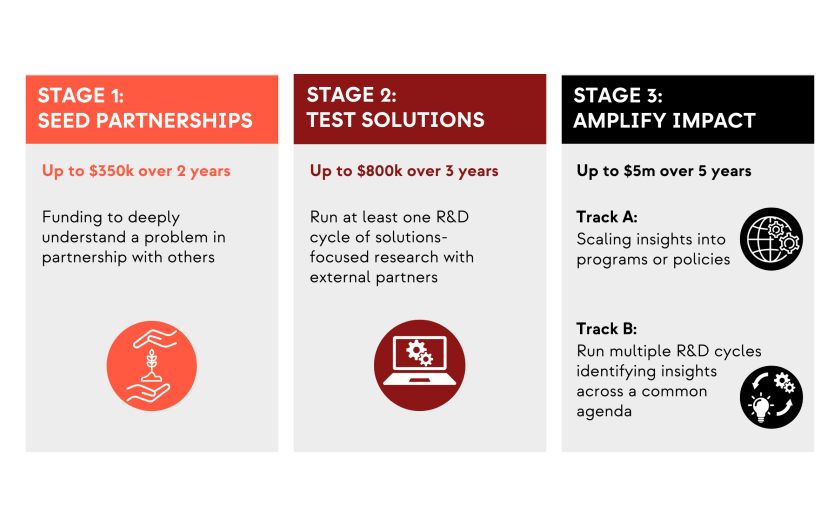We Have Three Funding Opportunities — Which Is Right for You?

Interested in partnership-based research to create tangible outcomes in the world? Our refreshed investment strategy includes three stages of funding to better support scientific insights from initial discovery to large-scale impact.
This flowchart should help you figure out whether Stage 1: Seed Partnerships, Stage 2: Test Solutions, or Stage 3: Amplify Impact is the right match for you and your partner. But what does it look like to be at each of these stages?

Just getting started thinking about partnership-based research...
If you’re a faculty member new to partnership-based research or don’t have a partner identified for the work you’re interested in pursuing, we highly recommend checking out the Stanford Impact Labs Design Fellowship (SILDF).
Have a new partner outside academia, but it is early days...
If you are a Stanford faculty member and have a partner outside the university who is interested in better defining a social problem and potential solution together, you may be a good match for an investment under Stage 1: Seed Partnerships. This may be a new partnership, so you may need to spend time to develop a trusted relationship.
Your long-term research goal is to test a solution to address a social problem, but you and your partner(s) may need more information about the drivers of a social problem to understand how to develop the most relevant and effective solution. Our Stage 1: Seed Partnerships investment supports teams with strong research questions and newer partnerships to help them move along the pathway towards a solutions-focused R&D cycle.
Your research-practitioner team is ready to test solutions together, marrying research skills and practical experience...
If your team already includes a Stanford faculty member and a partner(s) outside of academia who have designed a solution or set of solutions and are ready to put them to the test, then you may be a good fit for Stage 2: Test Solutions.
At this stage, you and your partner(s) have developed a strong relationship with clearly defined roles and shared objectives. You have relationships with the key decision-makers that will make or break the success of the proposed solution or have a concrete plan to develop those relationships. You and your partner know how you’re going to implement and test the proposed solution, and have a strong hypothesis about the pathway to putting the insights to use for society at a larger scale.
You're a research team, nonprofit organization, or government agency that is ready to put a well-demonstrated scientific insight to use at a larger scale...
What if your team has successfully tested a solution and are ready to put it to use at scale? Or, what if you’re a nonprofit or governmental agency that has worked with Stanford faculty to test a solution and are now ready to take the lead on scaling the insights?
In either case, you might be a match for Stage 3, Track A: Scaling Insights. Strong applicants may take different forms, but are unified in their desire to put scientific insights to use at a larger scale, with a clear plan for sustaining that work past the length of SIL’s investment. We’re open to a wide variety of different ways that you may wish to put your scientific insights to use at a larger scale. Nonprofits or government agencies can directly apply for SIL investment only once they have been sponsored by a Stanford faculty member.
Your team has a track record of partnership-based R&D cycles around a common theme that have been successfully put to use and want to pursue a longer-term R&D agenda...
Our Stage 3: Amplify Impact funding also includes a second track, Track B, to support teams who have an established track record of generating scientific insights that have already been put to use.
While we’re open to a wide variety of approaches, this funding could, for example, provide core support to an impact lab to run a set of connected R&D cycles that both test specific solutions in multiple settings and that have the potential in aggregate to help make transformative progress against a big social problem. Teams must demonstrate a strong track record of solutions-focused R&D cycles that have been successfully put to use for society, a compelling pipeline of new R&D cycles with partnerships in place to put research to use; and a strategy to develop future R&D cycles. Labs should also make clear how a multi-year investment in R&D in the problem area can generate a set of cumulative findings with the potential for transformative impact in science and practice.
Need more assistance understanding which pathway is right for you? We’re here to help!
- Read our Frequently Asked Questions
- Contact us via email at silinvestments@stanford.edu.
